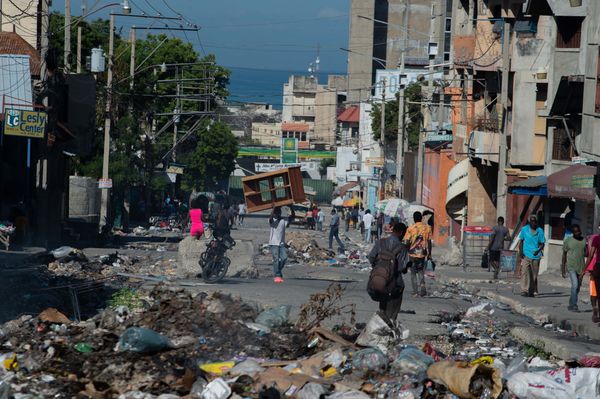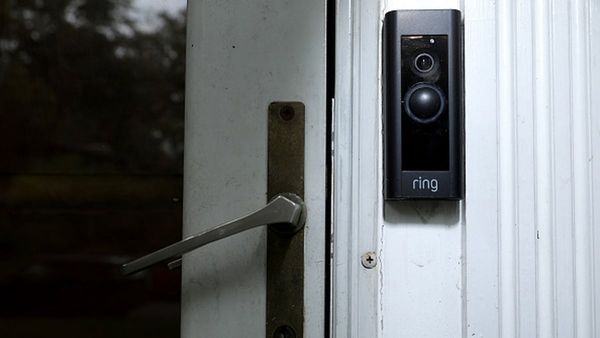
Scott Hallett, 49, has that country stoicism. He’ll tell you that, at any point in time, his legs will stop working and he’ll collapse – but it’s not that bad. He’ll tell you that one time it happened and the fridge came down on top of him, but that’s nothing to worry about.
He’ll tell you that, around his house in Yarraman, in regional Queensland, he has piles of supplies, muesli bars and water, because sometimes he can’t get up for days after one of his falls. He once had to lie there for a week, in his own mess, because he couldn’t get up.
He’ll tell you, in his soft, calm voice, that when he is alone, he wears a crash helmet, in case he hits his head on the way down. But really, he’ll say, it’s no big deal.
And if you let him keep talking he’ll tell you that, despite having a degenerative disease that is recognised by the agency running the national disability insurance scheme (NDIS), his seven applications for support from them have been rejected.
The National Disability Insurance Agency (NDIA) says there is an increase in people being accepted to the scheme. While data shows that more people are applying and being accepted, tens of thousands of people are still being rejected each year.
In the year to June 2025, it rejected 24,186 applications.
Dr Yi Yang, a senior fellow at the Melbourne Disability Institute, worked with other researchers to look at the NDIS applications of 485,676 people aged seven or older, made between 2016 and 2022, to see if they were deemed eligible.
They found three groups are more likely to be rejected from the scheme than others: people aged 55 and older, women and girls, and those who live in disadvantaged areas.
“We simply found there was uneven distribution,” she says.
“We found the differences were varied across different disability types. The largest differences were seen in people with physical disability in socioeconomically disadvantaged areas.
“For every 1,000 applications, there were 100 fewer successful requests made by people with physical disability in socioeconomically disadvantaged areas.”
The story that the numbers don’t tell, though, is what Hallett has been through.
Letters from the NDIA
“Last year, around about June, it got really bad,” Hallett says. “I started dropping all the time. Head plants on the ground, cracking the skull open, stuff like that.”
In 2014, he was working as a luggage loader for a cruise-ship company when his back went out. He thought it would heal in a week, but Hallett had degenerative lumbar disc disease, where the lower back wears down, causing vertebrae to rub against each other. The injury exacerbated it.
WorkCover found him 70% disabled, but after two years, that maxed out. His marriage broke down, he was homeless for seven months, living out of his car.
At the beginning, he would fall once a week.
Sign up: AU Breaking News email
Last year, his legs started to give out regularly, leaving him with concussions. He would go into fugue states – where he would believe he was a child again and try to get to a train station that doesn’t exist any more or start looking for the dial-up phone.
“Other times it could be I’ve just dropped and it’s hurting, but I can drag myself back up,” he says. “Or I’ll be knocked out, that’s a whole different kettle of fish. I wake up dazed and confused. Some days I didn’t even know who I was, wandering the streets.”
On his walls, he wrote: Your name’s Scott Hallett, you live here, you’ve got two cats, don’t call an ambulance, patch yourself up, you’ll be right.
Alarmed, his ex-wife quit her career at Qantas in December to look after him full-time. She has spent $65,000 to buy a caravan and move so she could live on his property. But she can’t do it for ever – she needs to go back to work.
He’s been told, in letters from the NDIA, that it’s been deemed that he hasn’t yet exhausted all his treatment options.
“How many people can’t get through the door?” he says. “How many people aren’t getting through or they’ve just given up and lost it? There’s a lot I think.”
‘We feel powerless’
In 2004, Rhys Roberts was asleep in a car full of his mates.
Then he was looking at the door handle of the Holden Commodore, trying to get himself out of the car, but only the top part of his body was moving. His friend had driven into another car, the sides colliding.
“I was just 17,” Roberts says. “Bam. Goodbye life.”
Roberts can hardly walk, often can’t feel his own feet, and is in constant pain. He struggles to get to the shops – and it can take him three hours. He can’t get into the shower by himself.
He has developed anorexia and hardly eats, afraid if he puts on weight, he won’t be able to pick himself up when he falls over. Despite this, seven applications for the NDIS have been rejected. He is at breaking point.
“It’s like, every time I breathe, it’s a brand new form of self-torture,” he says. “And it’s just getting worse and worse.
“I’m rooted for life.”
He is on the disability support pension (DSP). Aside from the one hour when a support worker comes once a week to shower him, he lives alone. The charity support service, Meliora, pays for the care.
He has been on antidepressants and anti-psychotic medication, but is now fighting bouts of suicidal thoughts.
“My advice to people would be, don’t break your back,” Roberts says. “Have enough money to get support.”
Like Hallett, Roberts has received rejection letters, seen by Guardian Australia, that say he did not get into the scheme because the NDIA believes they have not exhausted all treatment options for their conditions.
David Ryan, the director of support service Meliora, is preparing to take both Roberts’ and Hallett’s cases to the administrative review tribunal. He has been volunteering his time and the organisation’s money to get them the right reports, to apply again.
He says without the NDIS, both of them could die – Hallett’s ex-partner is physically unwell and can’t look after him much longer, and Roberts is increasingly suicidal.
“They’re right at the extreme level,” he says.
In both cases, they have been deemed disabled by either a private insurer or WorkSafe, they’re both now on the DSP, and have independent reports from occupational therapists showing they need to be on the scheme, he says.
Ryan has been working to help people with the NDIS since 2019, and says in the last four years “it’s definitely gotten harder”.
“The burden and the amount of evidence they’re wanting increases,” he says.
Desperate, Ryan has launched a donation page to help fund their care. He’s exhausted and frustrated with the system, but he knows it’s worth fighting for.
“We feel powerless,” Ryan says. “The process is exhausting and dehumanising.
“And we’re talking very negatively about it, but I’ve seen it change people’s lives. Absolutely transform them.
“It really does change lives when they get the package they need. It gives them back their humanity.”
In a statement, an NDIA spokesperson said there had been no changes to how it assesses eligibility for the NDIS.
“To meet access for the NDIS, a person must meet all eligibility criteria, as well as provide evidence of how their disability and reduced level functional capacity impacts their everyday life,” the spokesperson said.
“Over the past five years, more than 85% of applications to join the scheme were approved, with the rate of access met increasing in recent years.”
• In Australia, the crisis support service Lifeline is 13 11 14 and the Butterfly Foundation is at 1800 33 4673. In the UK and Ireland, Samaritans can be contacted on freephone 116 123, or email jo@samaritans.org or jo@samaritans.ie, and Beat can be contacted on 0808-801-0677. In the US, you can call or text the 988 Suicide & Crisis Lifeline at 988 or chat at 988lifeline.org, and help is available at nationaleatingdisorders.org or by calling ANAD’s eating disorders hotline at 800-375-7767. Other international helplines can be found at befrienders.org







